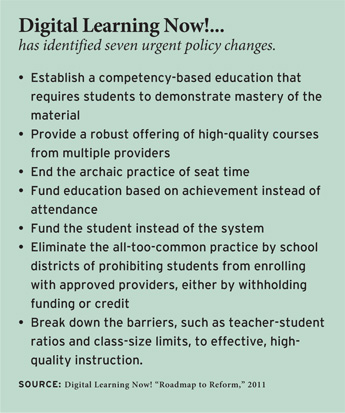When former governors Jeb Bush and Bob Wise strode to the stage at the 2011 Excellence in Action National Summit on Education Reform in San Francisco last October, Sal Khan had just shown the 750 attendees his vision of the digital future.
Khan is the former hedge-fund analyst turned education rock star who started Khan Academy, a nonprofit that reaches millions through its free online lessons and assessments. Tools like these, said Khan, can catapult education from its time-based roots toward a competency-based model in which students progress upon actual learning—mastery—instead of seat time.
At the same conference a year earlier, the two former governors, cochairs of Digital Learning Now!, released “10 Elements of High Quality Digital Learning.” This year, Bush and Wise said they had evaluated each of the 50 states against the elements and explained the assessment methodology they had used: states were judged against 72 individual metrics. (Disclosure: I was one of many who provided feedback on how different states ranked on the criteria and serve as a “digital luminary” for the Digital Learning Now! effort.) Rather than announce where the states fell in the ranking, the governors gave the crowd a preview of their “Roadmap for Reform,” a guide to help states navigate different paths toward changing their online education policies (see sidebar).
With the road map in place, one might assume that moving into the future will be a straightforward exercise: the pieces are all there and model legislation is forthcoming, so state policymakers just have to enact the 10 Elements.
Of course, things are never so simple, and many questions remain.
Some questions reflect legitimate disagreement over Digital Learning Now!’s recommendations, even among those who agree with its broad vision. An obvious flash point will be the idea that states require students to take at least one college- or career-prep course online to earn a high school diploma.
One argument in favor of the requirement is that the outcome from taking an online course—gaining the skills to succeed in a digital environment and perhaps become more self-driven—is valuable in a world in which postsecondary education and workforce training are increasingly done online. Yet some see this as yet another input-based requirement in a system already overburdened with mandates, and in conflict with the spirit of digital learning: if the experience is so important or compelling, won’t students naturally flock to online learning, particularly given Digital Learning Now!’s recommendation that dollars follow students to the online course of their choice?
Another consideration is that elementary-school students don’t take courses—at least in the sense that high-school and middle-school students do—and so ensuring that elementary-school students have access to online learning at the course level seems to miss some fundamental principle. According to the state report cards, though, several states have achieved their goals at the elementary-school level, which only raises more questions.
Many of the pieces that Digital Learning Now! casts as critical to the endeavor are not yet in place, and therefore no one actually knows how they will work in practice. For example, Digital Learning Now! has hitched its wagon to the enactment of the Common Core standards and accompanying next-generation assessments that should be in place by 2014. Whether these assessments will facilitate a competency-based learning environment unburdened by time—or lock in today’s system—is yet to be seen. States may abandon the digital effort when they see the up-front costs of implementing an online assessment system. And if they do, what will that mean for a plan that rests on paying for achievement instead of seat time? Valid, reliable, authentic, on-demand, and independent assessments are critical to moving to a system based on student learning outcomes. What about those courses that don’t fall under the Common Core? Does an outcome-based funding system require extending the Common Core to all subject areas, or will states create unique standards for subject areas other than math and English? Could entrepreneurs develop competency badges for their students that the public would recognize as legitimate? How would such competency measures be accredited?
A number of operational challenges need to be worked out as well. Utah, for example, passed in the spring of 2011 Senate Bill 65, based on the 10 Elements of High Quality Digital Learning. Utah state senator Howard Stephenson declared that the bill ends the “tyranny of time and place” in education by allowing dollars to follow high school students to their online course of choice. The legislation calls for the state to withhold 50 percent of the provider’s fee until the student successfully completes the course.
Not surprisingly, the devil has been in the details. Crafting a viable funding model for online courses that makes sense for districts and providers alike has not been easy. Even more challenging is helping schools and districts transition to a world in which students still need some of the services they provide but take most of their courses online. How does funding work in this model? How do schools create the flexible schedules and offer the critical services—many of which may be nonacademic—to accommodate students’ varying needs? How do they transition to this service—or community center—model?
A related set of issues plagues the funding model from the state’s fiscal perspective. If students progress based on competency instead of cohort, the state should presumably reward schools and providers that help students progress faster. And Digital Learning Now! suggests that it should reward those providers that help students make the most growth. Set aside for a moment the demands on state data systems created by an outcome-based system that rewards growth and the fact that these systems are not in place today. If this policy were in place, the state would be on the hook for paying for a student who masters, say, 20 half-semester courses in a given year, rather than a more conventional 12 or 14. How will states deal with this fiscal uncertainty? Holding back students seems like a poor choice, as does punishing schools that can educate students faster with less revenue.
And what if a student masters the high school curriculum by the time she is 15, as many students undoubtedly could? Does she go to college? Does she take time off? Or does she stay in high school with her friends but take college courses? If so, who pays?
Suggesting that a road map document could tackle such complexity isn’t fair. But a glimpse into the exciting— and uncertain—future presented by Digital Learning Now! does raise many legitimate questions. That’s no reason to delay implementing its recommendations though; innovation is never perfect right out of the box. Iteration in practice is critical. With the “Roadmap” coming on the heels of Khan’s conference presentation, surely some in the audience wondered whether innovations yet to come might even clear away many of the familiar roadblocks.
Michael Horn is cofounder and executive director of education at Innosight Institute.
This article appeared in the Spring 2012 issue of Education Next. Suggested citation format:
Horn, M.B. (2012). For Digital Learning, the Devil’s in the Details: State planning is key to progress. Education Next, 12(2), 82-83.




